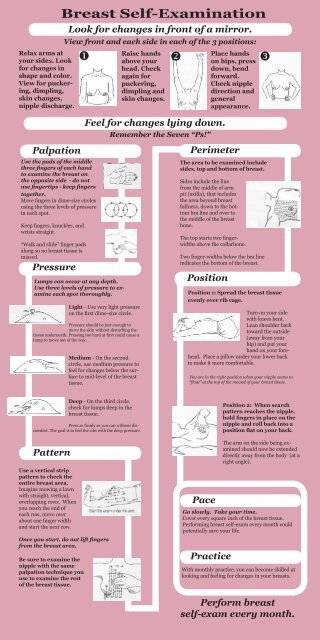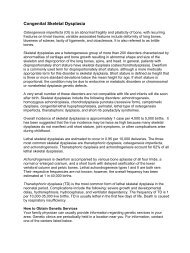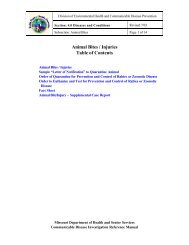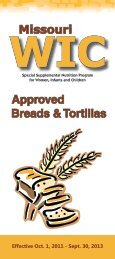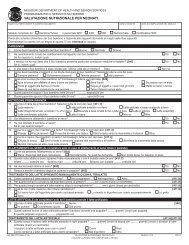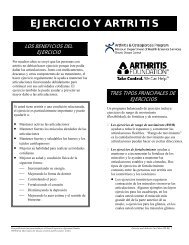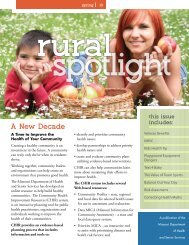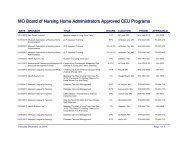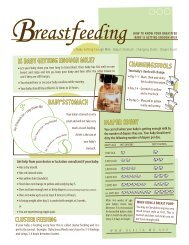Breast Self Exam Brochure - Missouri Department of Health & Senior ...
Breast Self Exam Brochure - Missouri Department of Health & Senior ...
Breast Self Exam Brochure - Missouri Department of Health & Senior ...
You also want an ePaper? Increase the reach of your titles
YUMPU automatically turns print PDFs into web optimized ePapers that Google loves.
Relax arms at<br />
your sides. Look<br />
for changes in<br />
shape and color.<br />
View for puckering,<br />
dimpling,<br />
skin changes,<br />
nipple discharge.<br />
Palpation<br />
Use the pads <strong>of</strong> the middle<br />
three fingers <strong>of</strong> each hand<br />
to examine the breast on<br />
the opposite side - do not<br />
use fingertips - keep fingers<br />
together.<br />
Move fingers in dime-size circles<br />
using the three levels <strong>of</strong> pressure<br />
in each spot.<br />
Keep fingers, knuckles, and<br />
wrists straight.<br />
“Walk and slide” finger pads<br />
along so no breast tissue is<br />
missed.<br />
Pressure<br />
Use a vertical strip<br />
pattern to check the<br />
entire breast area.<br />
Imagine mowing a lawn<br />
with straight, vertical,<br />
overlapping rows. When<br />
you reach the end <strong>of</strong><br />
each row, move over<br />
about one finger width<br />
and start the next row.<br />
<strong>Breast</strong> <strong>Self</strong>-<strong>Exam</strong>ination<br />
Once you start, do not lift fingers<br />
from the breast area.<br />
Be sure to examine the<br />
nipple with the same<br />
palpation technique you<br />
use to examine the rest<br />
<strong>of</strong> the breast tissue.<br />
View front and each side in each <strong>of</strong> the 3 positions:<br />
Lumps can occur at any depth.<br />
Use three levels <strong>of</strong> pressure to examine<br />
each spot thoroughly.<br />
Light - Use very light pressure<br />
on the first dime-size circle.<br />
Pressure should be just enough to<br />
move the skin without disturbing the<br />
tissue underneath. Pressing too hard at first could cause a<br />
lump to move out <strong>of</strong> the way.<br />
Medium - On the second<br />
circle, use medium pressure to<br />
feel for changes below the surface<br />
to mid-level <strong>of</strong> the breast<br />
tissue.<br />
Deep - On the third circle,<br />
check for lumps deep in the<br />
breast tissue.<br />
Press as firmly as you can without discomfort.<br />
The goal is to feel the ribs with the deep pressure.<br />
Pattern<br />
Look for changes in front <strong>of</strong> a mirror.<br />
<br />
Raise hands<br />
above your<br />
head. Check<br />
again for<br />
puckering,<br />
dimpling and<br />
skin changes.<br />
Feel for changes lying down.<br />
Remember the Seven “Ps!”<br />
Place hands<br />
on hips, press<br />
down, bend<br />
forward.<br />
Check nipple<br />
direction and<br />
general<br />
appearance.<br />
Perimeter<br />
The area to be examined include<br />
sides, top and bottom <strong>of</strong> breast.<br />
Sides include the line<br />
from the middle <strong>of</strong> arm<br />
pit (axilla), that includes<br />
the area beyond breast<br />
fullness, down to the bottom<br />
bra line and over to<br />
the middle <strong>of</strong> the breast<br />
bone.<br />
The top starts two fingerwidths<br />
above the collarbone.<br />
Two finger-widths below the bra line<br />
indicates the bottom <strong>of</strong> the breast.<br />
Position<br />
Position 1: Spread the breast tissue<br />
evenly over rib cage.<br />
Turn on your side<br />
with knees bent.<br />
Lean shoulder back<br />
toward the outside<br />
(away from your<br />
hip) and put your<br />
hand on your forehead.<br />
Place a pillow under your lower back<br />
to make it more comfortable.<br />
You are in the right position when your nipple seems to<br />
“float” at the top <strong>of</strong> the mound <strong>of</strong> your breast tissue.<br />
Pace<br />
Position 2: When search<br />
pattern reaches the nipple,<br />
hold fingers in place on the<br />
nipple and roll back into a<br />
position flat on your back.<br />
The arm on the side being examined<br />
should now be extended<br />
directly away from the body (at a<br />
right angle).<br />
Go slowly. Take your time.<br />
Cover every square inch <strong>of</strong> the breast tissue.<br />
Performing breast self-exam every month could<br />
potentially save your life.<br />
Practice<br />
With monthly practice, you can become skilled at<br />
looking and feeling for changes in your breasts.<br />
Perform breast<br />
self-exam every month.
How to<br />
<strong>Exam</strong>ine<br />
Your<br />
<strong>Breast</strong><br />
Why do a breast self-examination?<br />
There are many good reasons for doing a breast selfexamination<br />
each month. It is easy to do. When you get<br />
to know how your breasts normally feel, you may be able<br />
to feel a change. With practice, it should take about 15<br />
minutes each month. Early detection is the key to successful<br />
treatment and cure.<br />
Important Questions...<br />
When to do a breast self-examination?<br />
The best time to do breast self-examination is right after your<br />
period, when breasts are not tender or swollen. If you do not<br />
have regular periods or sometimes skip a month, choose a<br />
day and do it the same time every month.<br />
H<br />
SHOW ME<br />
ealthy<br />
Women<br />
Monthly<br />
<strong>Breast</strong> <strong>Self</strong>-<strong>Exam</strong><br />
(BSE)<br />
The Show Me <strong>Health</strong>y Women program is a joint project <strong>of</strong> the <strong>Missouri</strong> <strong>Department</strong> <strong>of</strong> <strong>Health</strong> and <strong>Senior</strong> Services and the Centers for Disease Control and Prevention, Grant Agreement<br />
#5U58000820-04. Alternate forms <strong>of</strong> this publication for persons with disabilities may be obtained by contacting <strong>Missouri</strong> <strong>Department</strong> <strong>of</strong> <strong>Health</strong> and <strong>Senior</strong> Services at 573-522-2845.<br />
Hearing and speech impaired citizens can dial 711.<br />
AN EQUAL OPPORTUNITY/AFFIRMATIVE ACTION EMPLOYER. Services provided on a nondiscriminatory basis.<br />
Revised 3/2011 #159<br />
Are you eligible for<br />
FREE Cancer Screenings?<br />
You may qualify for Show Me<br />
<strong>Health</strong>y Women if:<br />
You are age 35-64<br />
You are uninsured or under<br />
insured<br />
You meet income guidelines<br />
Refer to the phone numbers<br />
and the Web site on the right<br />
Lymph nodes drain breast tissue.<br />
<strong>Missouri</strong>’s<br />
The lymph nodes that drain the breast tissue are located in three<br />
areas:<br />
• Above your collar bone<br />
• Below your collar bone<br />
• In the armpit<br />
<strong>Breast</strong> and Cervical Cancer Screening Program<br />
Cancer Information Service<br />
1-800-4-CANCER<br />
(1-800-422-6237, choose option #1)<br />
<strong>Missouri</strong> <strong>Department</strong> <strong>of</strong> <strong>Health</strong> and <strong>Senior</strong> Services<br />
920 Wildwood Drive, P.O. Box 570, Jefferson City, MO 65102-0570<br />
Web address: www.health.mo.gov/living/healthcondiseases/<br />
chronic/showmehealthywomen<br />
Phone: 573-522-2845<br />
Check the lymph nodes...<br />
You will want to know if any nodes are enlarged, movable or<br />
unmovable.<br />
H<br />
SHOW ME<br />
ealthy<br />
Women<br />
Remember the ABCs <strong>of</strong> <strong>Breast</strong> <strong>Health</strong><br />
A screening mammogram<br />
B reast self-examination<br />
C linical breast examination<br />
A breast self-examination can save your life. Most breast<br />
lumps are found by women themselves or their partners.<br />
Most lumps in the breast are not cancer. Any lump or<br />
change should be checked by a doctor.<br />
Early detection is your<br />
best protection!


